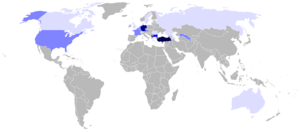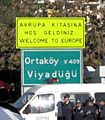Turkish language facts for kids
Quick facts for kids Turkish |
|
|---|---|
| Türkçe | |
| Pronunciation | [ˈt̪yɾkˌtʃe] |
| Native to | Albania, Azerbaijan, Bosnia and Herzegovina, Bulgaria, Croatia, Cyprus, Greece, Hungary, Iraq, Kosovo, Lebanon, Republic of Macedonia, Moldova, Montenegro, Northern Cyprus, Palestine, Romania, Russia, Serbia, Syria, Turkey, Uzbekistan, and by immigrant communities in Austria, Belgium, France, Germany, Italy, The Netherlands, Switzerland, United Kingdom, United States and other countries of the Turkish diaspora |
| Region | Anatolia, Cyprus, Balkans, Caucasus, Central Europe, Western Europe |
| Native speakers | over 77 million worldwide (date missing) |
| Language family | |
| Writing system | Latin alphabet (Turkish variant) |
| Official status | |
| Official language in | *See Cyprus Dispute. **In municipalities with more than 20% Turkish speakers. *Turkish is one of regional languages. |
| Regulated by | Turkish Language Association |

Countries with significant Turkish-speaking populations
|
|
Turkish (Türkçe) is a fascinating language spoken by over 77 million people around the world! Most speakers live in Turkey and Cyprus. You can also find Turkish speakers in countries that were once part of the Ottoman Empire, like Bulgaria and Greece. Millions of Turkish immigrants also live in Europe.
Turkish belongs to the Turkic language family. Some experts also believe it's part of an even bigger group called Altaic languages. Like Finnish and Hungarian, Turkish uses something called vowel harmony. This means that vowels in a word tend to sound similar to each other. In Turkish sentences, words usually follow a subject-object-verb order.
Contents
A New Alphabet for Turkish
Turkish was written using the Arabic alphabet for a very long time, from about the year 900 until 1928. But then, a big change happened! Mustafa Kemal Atatürk, who was the first president of Turkey, decided to switch to the Latin alphabet.
Why the Change?
The main reason for this change was to make it much easier for people to learn to read and write. The government wanted to increase the number of people who could read, which is called literacy. And it worked! After the alphabet reform, the number of people who could read grew a lot.
Some people also think this change helped Turkey move away from its past as the Ottoman Empire. Old documents from that time are now hard to read for most people.
The Turkish Latin Alphabet
The new Latin alphabet for Turkish was created to match the actual sounds of spoken Turkish. It wasn't just a simple copy of the old writing system.
The Turkish alphabet has 29 letters. Seven of these letters (Ç, Ğ, I, İ, Ö, Ş, and Ü) were changed from their original Latin forms. This was done to make sure they could represent all the unique sounds in Turkish. This new alphabet is very good at showing how Turkish words are pronounced. It is the official alphabet used today.
Turkish Language Family
Turkish is most closely related to other Turkic languages. These include languages like Azerbaijani, Turkmen, Uzbek, and Kazakh.
There's also a theory that Turkish is part of the larger Altaic languages group. If this theory is true, then Turkish would be related to languages like Japanese, Mongolian, and Korean.
Turkish in Northern Cyprus
Turkish is the main language spoken in the Turkish Republic of Northern Cyprus. However, the Turkish spoken there is a bit different from the Turkish spoken in Turkey. It's known as Cypriot Turkish.
Simple Turkish Phrases
Learning a few basic phrases can be fun! Here are some common Turkish words and sentences:
- Merhaba = Hello (formal)
- Selam = Hello (informal)
- Nasılsın? = How are you?
- İyiyim = I'm fine
- Teşekkür ederim = Thank you (formal)
- Teşekkürler = Thanks
- Sağ ol = Thank you (informal)
- Benim adım ... = My name is ...
- Türkçe bilmiyorum. = I don't speak Turkish.
- İngilizce biliyor musunuz? = Do you speak English?
- Tekrarlar mısınız? = Can you repeat it?
- Evet = Yes
- Hayır = No
- Belki = Maybe
- Biraz = A little
- Acıktım. = I'm hungry.
- Dur! = Stop!
- Yapma! = Don't do it!
- İstemiyorum. = I don't want it.
- Tabii = Sure
- Bekledim. = I waited.
Images for kids
-
Map of the main subgroups of Turkish dialects across Southeast Europe and the Middle East.
-
Road sign at the European end of the Bosphorus Bridge in Istanbul. (Photo taken during the 28th Istanbul Marathon in 2006)
See also
 In Spanish: Idioma turco para niños
In Spanish: Idioma turco para niños









